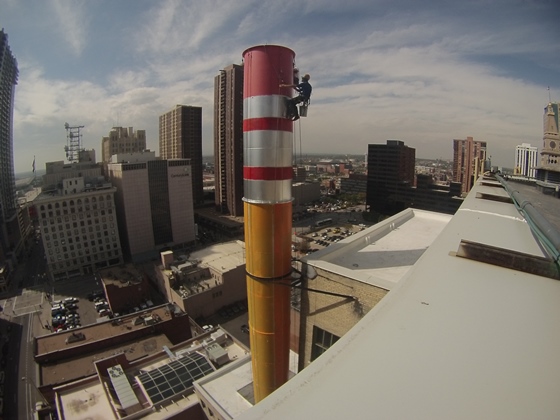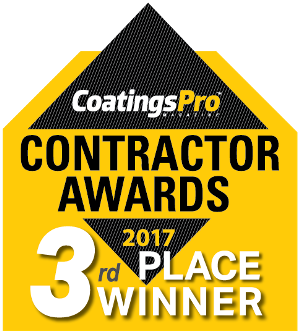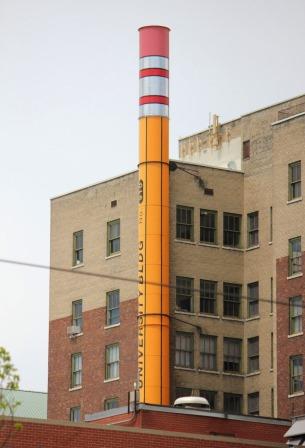The historic University Building in downtown Denver, Colorado was first built in 1910, with a nondescript, gray smokestack sticking up from the top. In its early years, the smokestack would vent the coal-fired boilers that were used to heat the 12-story structure.
But given the building’s use for over 100 years, renovations have often been necessary to keep it viable. So when ownership group 910 Associates, Inc. recently decided to renovate the ground floor, they also opted to freshen up the look of the dilapidated, rusty metal smokestack with a new, decorative coat of paint.
The skinny dimensions of the 150-foot (45.7 m) tall, 12-foot (3.7 m) diameter smokestack, however, posed unique challenges from the standpoint of both access and aesthetics. Fortunately for the client, one creative coatings contractor was ready to pencil in solutions.
Erasing the Smokestack
“We were initially hired to just paint,” said Rich Purnell, CEO of rope access painting company BASE Group, based in nearby Arvada, Colorado. “They didn’t really know what color they wanted to go with. I was sitting in the office with the client, and he said they’d like to do something with it rather than just another color, but they didn’t know what to do.”
“The No. 2 pencil was actually my idea,” Purnell added. “They loved the idea and it was approved almost immediately.” From there, Purnell worked with an artist he knew from a separate project to finalize the design.
“Even though it seems to be simple, I hired out an artist to get six different shades of yellow,” Purnell said. “A pencil is an octagon, whereas the actual smokestack is round. So we wanted to use different colors and add depth to it to showcase the sides.”
Sharp Access Plan
Purnell got into the painting business because he used to be a professional ice climber. In the summer, he would paint houses and then save the money to take the winter off to climb ice. After a few years, he combined his climbing talents with his trade of painting by launching BASE Group as rope access specialists. For the giant pencil job, that rope expertise proved essential.

“Access was tough,” Purnell recalled. “Where that project sat, it’s actually on a rooftop within a large building, far away from any street. So you weren’t getting a crane unless you were getting a huge, swing-stage crane, and I don’t think these guys had the budget for that. So we decided to use our expertise with rope access.”
Using ropes from New England Ropes, a fall protection system from Petzl, and safety gear including hard hats from local suppliers, the four-man BASE crew quickly went to work. Purnell initially expected his crew to have to climb the smokestack, but they were ultimately able to access the top of the stack via the roof. “We thought we would have to climb it, but we were relieved that we could stand on the rooftop and throw a rope down the center, then ascend that line to fix our main working ropes,” he said.
 Once Purnell’s crew accessed the tall structure — typically with three crew members on ropes and one person on the ground to monitor and assist — proper surface preparation was critical to prepare the site for its eventual transition to a pencil.
Once Purnell’s crew accessed the tall structure — typically with three crew members on ropes and one person on the ground to monitor and assist — proper surface preparation was critical to prepare the site for its eventual transition to a pencil.
On a few smaller areas with rust, the Society for Protective Coatings (SSPC) Surface Profile (SP) 11: Power Tool Cleaning to Bare Metal standard was used as a guideline. “There were a couple areas where we had to use grinders because of the rust,” Purnell said. “But overall, for being as old as it was, it wasn’t in bad shape.”
As a result, for most of the structure, the SSPC-SP-2: Hand Tool Cleaning standard, which removes all loose mill scale, rust, and paint by hand chipping, scraping, sanding, and wire brushing, was sufficient along with pressure washing. “From there, we mapped off the sections and were ready to paint the pencil,” Purnell said.
The trick was that all three painters had to work in sequence on each phase of the job. “You couldn’t have someone power washing and someone painting,” Purnell explained. “We’d start at the top and go up and down together.”
Passing the Final Test
Once they reached the painting phase, the crew used the Duration exterior acrylic coating from Sherwin-Williams based on its compatibility with their desire for multiple shades of yellow.
“Duration is a really good exterior paint because it holds the color really well,” Purnell said. “We went with that because we wanted to use toners. They can tint with the Ecotoner and get a deeper color and a deeper base. There were so many different shades there.”
Based on the intricacy of the structure and its dimensions, Purnell believed roller application was necessary to ensure precision. Using 9-inch (22.9 cm) rollers with a 0.375-inch (9.5 mm) nap, the crew applied the Duration coating at a wet film thickness (WFT) of 4 to 6 mils (101.6‒152.4 microns).
While most of the pencil structure was painted yellow in varying shades, the “eraser” design at the top required silver and pink tinting. In particular, the silver portion, which needed to reflect the metal texture seen on an actual pencil, was a unique challenge. Fortunately for the client, Purnell had a plan in mind to address that concern by switching to the MIO Aluminum coating from Sherwin-Williams for the “metal” parts of the eraser.
“That was my special touch on the project,” Purnell said. “The MIO Aluminum is one of my personal favorite paints, because it has that reflection. It’s somewhat glossy yet matte at the same time. It’s just a nice silver color, and because it’s a moisture-cured urethane, it will stay on there forever. It’s typically used as a primer, but it can be used as a topcoat. And it ended up being absolutely perfect.”
 Each crew member carried two kits of paint on the ropes, including both the Duration and MIO Aluminum. Because the MIO Aluminum required extra curing time, they typically did small portions of the eraser before moving onto other parts of the structure beneath them.
Each crew member carried two kits of paint on the ropes, including both the Duration and MIO Aluminum. Because the MIO Aluminum required extra curing time, they typically did small portions of the eraser before moving onto other parts of the structure beneath them.
“That’s why the job took some time,” Purnell said. “Typically a crew of three could paint it in a day, but you have to paint it and let it dry. When you’re on ropes, your feet are always on something. So if you don’t let it cure or dry, you’re going to track stuff and you’re going to mess with the thickness. Everybody has to be [in sync] and doing the same thing.”
The finishing touch was the addition of the stenciled “University Bldg.” name, using black lettering to resemble classic pencil-brand logos. In all, the job was completed within about two weeks, including the complex preparation phases. Based on the feedback, it’s safe to say Purnell and his crew passed their test.
“They loved it,” Purnell said of the client’s response. “That thing is plastered all over the Internet. It’s like a landmark in Denver now, and it even won the Mayor’s Design Award. It definitely sticks out like a sore thumb, and it brought some attention to the building. If you drive downtown on Speer Boulevard, you can’t miss it.”
The crew won third place for this project for Specialty Projects in CoatingsPro’s inaugural Contractor Awards Program, too. That’s one job that shouldn’t be erased!